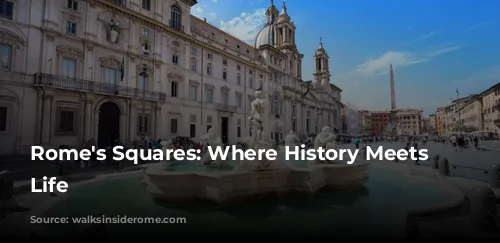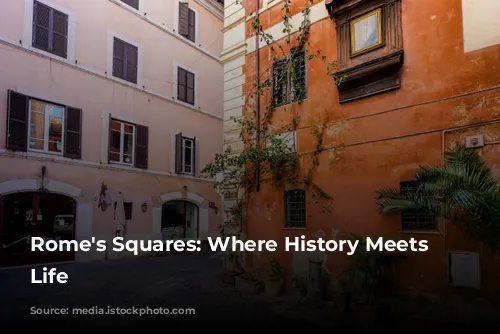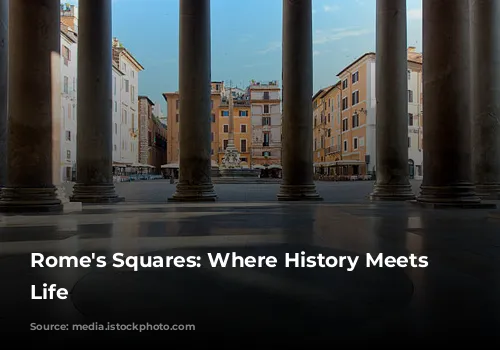Rome is a city steeped in history, its streets lined with ancient monuments, grand churches, and lush gardens. But beyond these iconic landmarks lie squares that pulse with the city’s vibrant energy, serving as stages for political rallies, captivating concerts, vibrant shows, and the everyday social life of Romans. Let’s embark on a journey to explore some of Rome’s most captivating squares, each with its own unique character and charm.
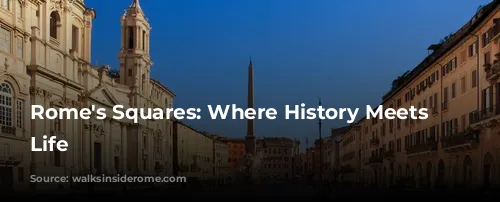
Piazza del Popolo: The People’s Square
Piazza del Popolo, meaning “People’s Square,” is undoubtedly Rome’s most famous square. Its central location makes it a natural gathering place for concerts and performances, drawing crowds from all corners of the city. The square’s captivating design is a feast for the eyes. Twin churches stand proudly on one side, while the Flaminio Obelisk pierces the sky at its heart. On one end, the Fountain of Neptune offers a refreshing respite, while a set of majestic steps lead to the Pincian Hill on the other.
However, the grand space we see today didn’t always exist. The original square, a modest affair along the Via Flaminia, was dramatically transformed in the early 19th century by architect Giuseppe Valadier. He drew inspiration from Bernini’s masterpiece, St. Peter’s Square, creating a spacious gathering place that resonates with the city’s dynamism. This breathtaking transformation turned Piazza del Popolo into a major meeting point, welcoming visitors from all over the world, eager to soak in its beauty and history.

St. Peter’s Square: A Place of Faith and Wonder
Nestled within Vatican City, St. Peter’s Square stands as a testament to faith and awe-inspiring architecture. Facing the colossal St. Peter’s Basilica, one of the largest churches in the world, the square draws visitors from all walks of life. Its unique design, a sprawling expanse framed by a majestic colonnade, invites you to linger and marvel. The square comes alive with vibrant activity throughout the day. Visitors can be seen gazing at the numerous statues adorning the colonnade, the ancient obelisk standing tall at the center, or the basilica’s towering grandeur.
The square is often bustling with activity, particularly on Sundays and Wednesdays. These days hold special significance for the faithful, as it’s the time when the Pope, if not at his summer residence in Castel Gondolfo, graces the square with his presence. This opportunity to catch a glimpse of one of the most recognizable figures in the world draws a sea of visitors, eager to experience this momentous event firsthand.
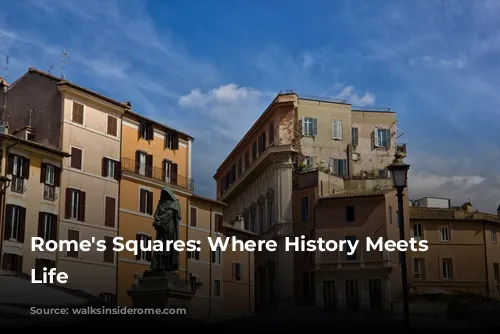
Piazza di Spagna: Elegance and Charm
Renowned as the most elegant square in Rome, Piazza di Spagna exudes a captivating allure. Surrounded by one of the city’s most prestigious shopping districts, it’s a destination for those seeking both luxury and beauty. The square’s most prominent feature, the iconic Spanish Steps, a cascading staircase leading from the square to the Trinità dei Monti church, draws countless visitors. It’s a must-visit for many, a symbol of Rome’s timeless elegance.
The square’s charm intensifies in the spring, when it bursts into a colorful spectacle. Azaleas in full bloom create a vibrant tapestry, adding a splash of color to the already enchanting setting. Besides the celebrated Spanish Steps and the nearby high-end boutiques, Piazza di Spagna also boasts the Fontana della Barcaccia, known as the “Fountain of the Ugly Boat.” Located at the base of the Spanish Steps, this exquisite fountain, designed by Bernini, has stood majestically since 1627. Its water, sourced from the ancient Roman aqueduct Acqua Vergine, is still drinkable today, a testament to Rome’s enduring legacy.
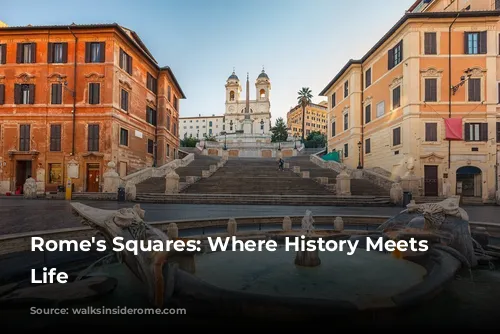
Piazza Navona: A Blend of History and Entertainment
In the heart of Rome’s historical center, Piazza Navona is impossible to miss. Once an ancient Roman race track, this long square is a lively hub of activity, buzzing with the energy of its numerous restaurants, street performers, artists, and museums. For those seeking an authentic Roman experience, Piazza Navona is the perfect starting point for an unforgettable evening.
While the impressive buildings lining Piazza Navona give the square its distinct shape and structure, it’s the fountains that truly capture the imagination. The Fountain of the Four Rivers, the Fountain of the Moor, and the Fountain of Neptune, strategically placed in the center, create a captivating spectacle. The most renowned of these is the Fountain of the Four Rivers, a masterpiece by Bernini, crowned with an Egyptian obelisk. Each river symbolizes the most influential river of its respective continent at the time of Bernini. Can you name them?
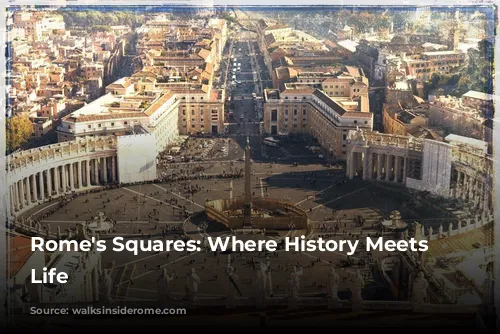
Campo de’ Fiori: Where History Meets the Market
Another vibrant square, Campo de’ Fiori, draws crowds with its bustling market and lively atmosphere. Dedicated to Giordano Bruno, whose statue stands proudly at its heart, this historic square in the Trastevere neighborhood transforms into a lively entertainment hub by night.
Despite its dark past, Campo de’ Fiori is now best known for its bustling market. Every morning, from Monday to Saturday, the square comes alive with vendors offering a wide array of local produce, crafts, and delicacies. Even after the market closes, there’s plenty to see and do. Explore the nearby bars and terraces, or wander through the charming medieval streets, each with its own story to tell.

Piazza Colonna: Ancient and Modern Intertwined
Located near the majestic Altare della Patria and Piazza Venezia, Piazza Colonna is a fascinating blend of ancient and modern Rome. The square’s namesake, the Column of Marcus Aurelius, a towering marble column, stands majestically at its center. Surrounding the square are magnificent palaces, including the seat of Italy’s government.
Adding to its intrigue, the square boasts a bronze statue of St. Paul, which was added to the Column of Marcus Aurelius in the 16th century. This unique blend of Roman and Christian history, commissioned by Pope Sixtus V, makes Piazza Colonna a compelling destination for history buffs and art lovers alike.
From the grand Piazza del Popolo to the vibrant Campo de’ Fiori, Rome’s squares are a microcosm of the city’s history and energy. Each square has its own unique charm, beckoning visitors to explore its beauty, discover its stories, and experience the rhythm of daily life in this timeless city.


